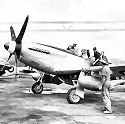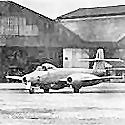
Mustang Ops in Korea
Meteor Ops in Korea

 | Mustang Ops in KoreaMeteor Ops in Korea |  |
Pohang, South Korea The 38th parallel had been crossed, by US forces, before the end of September 1950 and a decision was made to relocate 77 Squadron to a Korean airfield allowing the Mustangs to strike at North Korea without long transits. Thus on 12 October 1950, 77 Squadron deployed forward to Pohang (airfield K3) on the east coast of South Korea and began operations the following day. On 19 October four Mustangs, led by Wing Commander Cresswell, set out from Pohang to attack targets close to the North Korean capital of Pyongyang. The flight was split into two elements by a Forward Air Controller (FAC) with one element targeting enemy positions holding up the UN advance and the second element directed against a train approximately seven miles north of Pyongyang. FLTLT I. Olorenshaw and SGT E. Douglas, attacked the train by directing their firepower against opposite halves, Olorenshaw attacking the northern half and his wingman attacking the southern half. Douglas scored a direct hit on the box cars of the southern half and Olorenshaw hit the northern half with napalm. Both sections of the train caught fire and the box cars exploded violently. The remainder of the train was strafed and the locomotives boiler was seen to explode, sending a cloud of steam some 400 ft into the air. Flight Lieutenant Olorenshaw was awarded the American Air Medal for his skill during the attack. The same day Pyongyang was captured by advancing UN forces as they pushed toward the Yalu River (the border between Korea and Manchuria) and it appeared as if the war would soon be won. However, the Chinese, who until this time had only supplied arms to the north, entered the war and halted the UN forces before they could reach the border in strength. 77 Squadron first clashed with Chinese troops on 1 November 1950 when four Mustangs napalmed, rocketed and strafed a large number of Chinese troops who were holding up the advance of the 3rd Division of the Republic of Korea Army. The enemy was not the only danger in Korea and the Squadron suffered a major shock when FLTLTs C. Kirkpatrick and V. Gray died from burns received in a tent fire at 0400 hrs on the 14 November. Yonpo, Korea On 16 November the Squadron was relocated further forward to Yonpo (near Hamhung), to keep as close to the front lines as possible. The strength of the combined Chinese and North Korean forces was sufficient to push the UN forces back and throughout November 77 Squadron Mustangs attacked enemy transports and flew close air support (CAS) missions for the embattled UN forces. 77 Squadron was also called upon to provide CAS for Australian troops (the first time since the start of the conflict) who were making a counter attack against Chinese forces at Pakhon. The Squadron's Mustangs flew constant attacks against swarms of enemy tanks and vehicles, as they moved along the roads leading from Manchuria, inflicting heavy casualties. On the 24 November 1950 General MacArthur ordered the UN forces onto the offensive once again, but the situation was hopeless. The 1st Division of the US Marines found themselves surrounded by seven enemy divisions, and for the first time in their history were, as their General put it, "ordered to advance in another direction ". During the retreat back to South Korea all available aircraft moved to the airfield at Yonpo inside the Hamhung - Hungnam defence perimeter. Tension mounted at Yonpo as the enemy advanced ever closer to the airfield, all personnel were ordered to carry firearms and to prepare to defend the base. Bad weather was hampering operations at snow bound Yonpo and the ground crews worked ceaselessly in sub-arctic conditions to keep the Mustangs airworthy. Word was received to abandon the airfield and on 3 December 1950 the Squadron's aircraft flew their last mission from Yonpo and landed at their new base, Pusan. Pusan, South Korea 77 Squadron's Mustangs struck hard at the enemy's supply lines, destroying many trucks, railroads and bridges. The enemy struck back at the Mustangs with concentrated anti-aircraft fire and many aircraft returned to base with tell-tale bullet holes. The Squadron lost its sixth pilot on 22 December 1950 when Sergeant D. Ellis (A68-726) was shot down by ground fire whilst carrying out a reconnaissance mission near Pyongyang. A week later SQNLDR Cresswell had a lucky escape, when a bullet passed through the canopy of his Mustang as he strafed an enemy village. Seoul, the South Korean capital was captured by the Chinese army on 4 January 1951. The Squadron suffered another casualty, on 6 January 1951, when Sergeant C. Stephens (A68-765) crashed on flat ground near Munsan during an armed reconnaissance sortie. There was no sign of enemy activity in the area and cause of the crash remains a mystery. Chinese Communist Force Headquarters, Pyongyang was the target for the Squadron's first autonomous mission on 19 January 1951. The plan called for two sections of 6 aircraft each. The first section armed with two 500 lb general purpose (GP) bombs and four rockets. The second section armed with two napalm bombs and four rockets. The first section opened the attack by dive bombing the headquarters buildings, scoring four direct hits. The second section then attacked with both its napalm and rockets. The anti-aircraft fire was intense but was quickly silenced when the first section returned to strafe the gun positions. Sergeant C. Howe reported elevator damage from ground fire and Lieutenant G. Harvey radioed that his aircraft (A68-772) was losing power and that he was going to attempt a forced landing. Harvey successfully landed wheels up on an island in the frozen Taedong River, just north west of the North Korean capital. The following day four of the Squadron's Mustangs searched in hope that Harvey may have evaded capture. The search failed to find any trace of the missing airman who had been taken prisoner soon after landing. FLTLT Harvey (the first pilot in the Squadron to fly 100 missions) spent the remainder of the war in appalling conditions in a Chinese POW camp and was released on 28 August 1953. He later commanded 77 Squadron in Malaya, flying Sabre jet fighters. The UN retreat ended just 25 miles south of Seoul and there began the slow push north to recapture the lost ground. 77 Squadron contributed twelve aircraft to a forty aircraft formation, tasked with destroying enemy bivouac areas and villages in the Yangpyong area, on 29 January 1951. The attack left eight villages burning fiercely and killed scores of enemy troops. Another strike was carried out against enemy supply dumps near Chuchon on 13 February 1951, resulting in the destruction of a large quantity of enemy supplies and vehicles. The following day was a black one for the Squadron, with two pilots failing to return from an aborted CAS mission. Bad weather had prevented a section of four Mustangs from contacting their ground controller and the decision was made to jettison their napalm and return to base. On entering a cloud bank the section divided into two flights of two aircraft, soon after a radio call announced "I am spinning and am going to bail out". When the first flight cleared the cloud bank they found no sign of the other two aircraft and it was assumed that Warrant Officer S. Squires (A68-796) and Flight Lieutenant K. Matthews (A68-812) had suffered a mid-air collision. An exhaustive search was carried out the following day without result and neither man was ever seen again. The Squadron's bad luck continued when, on 29 February 1951, Sergeant K. Royal (A68-704) was killed as he attempted to force land his Mustang after it lost oil pressure during a patrol. Seoul was retaken by the UN forces on the 15 March 1951. 77 Squadron continued to give support to the advancing troops and on the day Seoul was retaken, the Squadron attacked an enemy village north of Kimpo, destroying twelve buildings. Sergeant Meggs (A68-737) suffered a loss of oil pressure during the attack and was forced to execute a wheels up landing at Kimpo airfield. Kimpo at this time was very close to the front line and Meggs had to be rescued from the airfield by helicopter. The UN forces finally crossed the 38th parallel for the second time, on the last day of March. The Squadron suffered yet another casualty on 19 March 1951. Whilst carrying out an attack on a village near Wonsan, Sergeant H. Strange (A68-782) reported that he had been hit by flak and he was losing oil pressure fast. His flight leader, Pilot Officer L. Klaffer, ordered him to head east and bail out over Wonsan Bay. Strange headed out to sea and after jettisoning his canopy bailed out of his crippled Mustang. Klaffer observed Strange vacating his aircraft and was horrified to see him plummet into the water, his parachute having failed to open. A helicopter from a nearby USN aircraft carrier was quickly on the scene and advised that there was no sign of Strange. On 23 March 1951 the Squadron participated in the largest parachute operation of the Korean War, code named 'Operation Tomahawk'. Eight Mustangs from the Squadron escorted 120 USAF transport aircraft over the Munsanni area and helped destroy any opposition from the enemy ground forces. The last few months had taken quite a toll on the Squadron and it was with some relief that, on 4 April 1951, the Squadron received the news that it was to withdraw to Iwakuni and begin conversion onto the long awaited Gloster Meteor jet fighters. The Squadron flew its last operational Mustang sortie on 6 April 1951, when four of the Squadron's aircraft had to abort an attack on a North Korean road due to bad weather. The Squadron moved to Japan on the following day and prepared to convert onto the new aircraft. The Squadron suffered its last Mustang casualty when Sergeant R. Robson (A68-128) crashed and lost his life at Matsuyama on the west coast of Shikoku Island on 17 April 1951, during a night navigation exercise. The value of 77 Squadron's contribution to its role with Mustangs is evident from the decorations conferred after return to Iwakuni. The Australian decorations included a bar to Wing Commander Spence's DFC. Five more DFC awards were made to Flight Lieutenants J. Adams, S. Bradford, C.R. Noble, W.C. Horsman and K.D. McLeod. The AFM was awarded to Warrant Officer B. Nicholls and Flying Officer G. Thornton AFC. The American awards totalled one Legion of Merit, thirteen DFCs and forty-eight Air Medals.
|
|
| © Australian Album © |